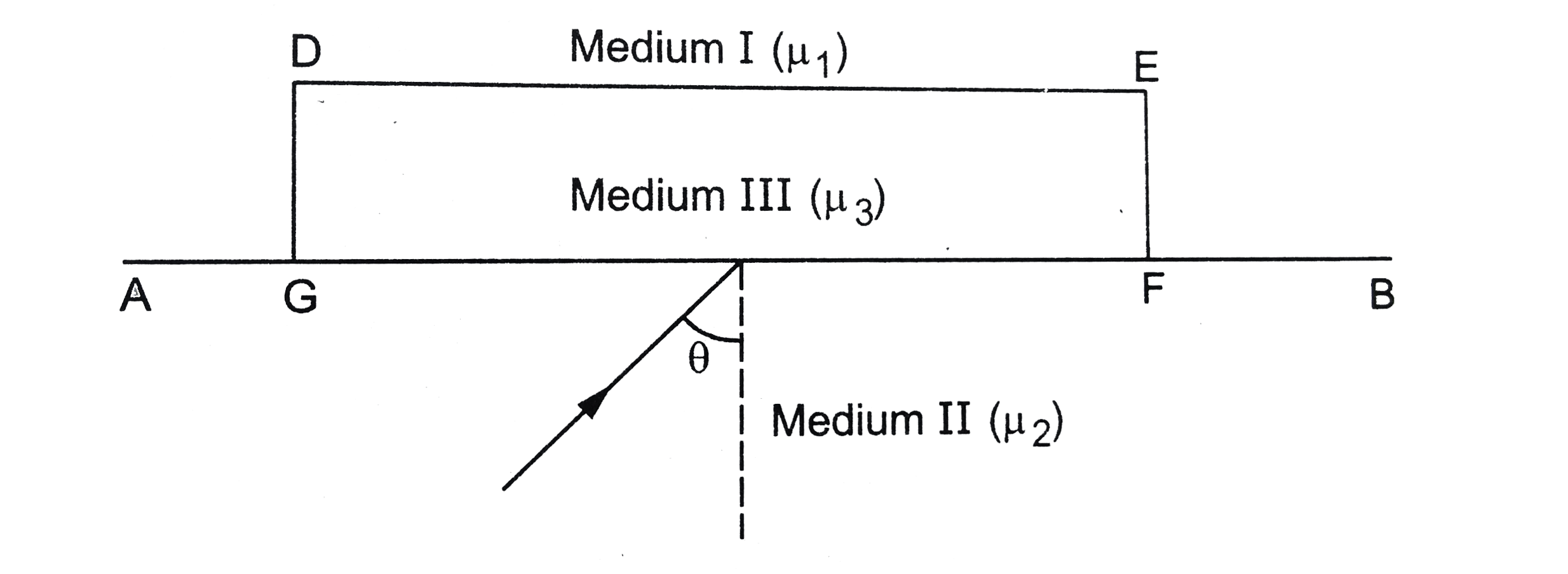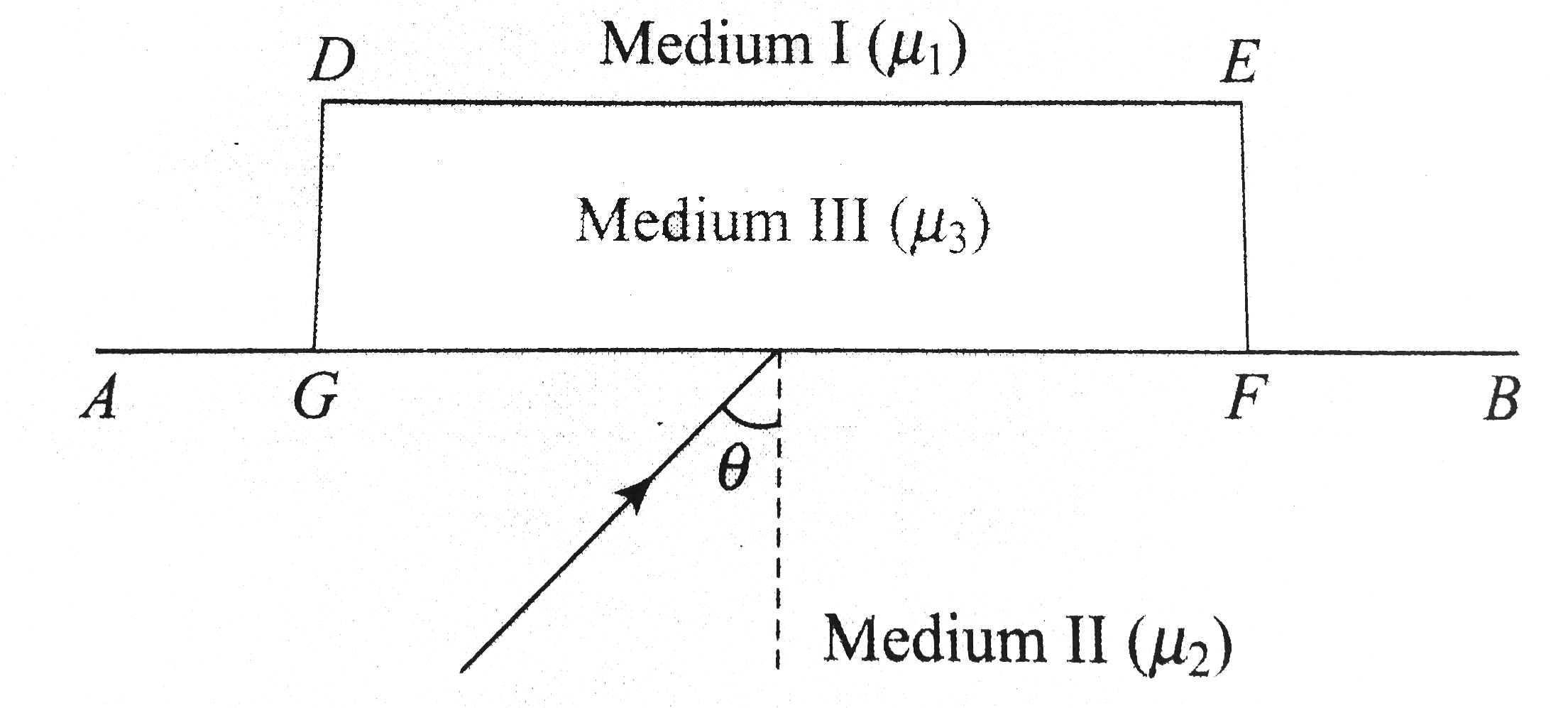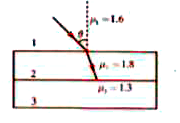Monochramatic light is incident on the pane interface AB between two media of refractive indices μ1 and μ2(μ2>μ1) at an angle of incidence theta as shown in figure. The angle theta is infinitesimally greater thannte critical angle for the two media so thast total internal reflection takes place. Now, if a transparent slab DEFG of uniform thickness and of refractive inde μ2 is introduced on theinterface (as shown in figure ) , show that for any value of μ2 all light will ultimately be reflected back into medium II.
 Solution in Gujrati
Solution in Gujrati
We shall use the symbol to mean infinitesimaly greater than. ltbr> When the slab is not inserted θ¯¯¯¯¯¯>θc=sin−1(μ1μ2)
or sinθ¯¯¯¯¯¯>μ1μ2.
When the slab is inserted. We have two cases μ3≤μ1andμ2>μ1.
Case I: mu_2lemu_1<br>Wehavef∈dsinθ¯¯¯¯¯¯>μ1μ2¯¯¯¯¯¯>μ3μ2
thus, the light is incident on AB at an angle greater than the criticle angle sin−1(μ3μ2).Itsuffers→tal∫erNAlrelfectionandgoesback→mediumII.<br>CaseImu_3gtmu_1<br>sintheta bargt mu_1/mu_2ltmu_3/mu_2<br>Thusthean≥lof∈cnceθmaybesmal≤rthanthecritical∠sin^-1 (mu_3/mu_2)andhenceitmayentermediumIII.The∠ofretionθisgivenbyure.<br>(sintheta)/(sintheta')=mu_3/mu_2.............i<br>or sintheta'=mu_2/mu_3sintheta<br>bargtmu_2/mu_3.mu_1/mu_2<br>Thussinθ¯¯¯¯¯¯>μ1μ3
Topper's Solved these Questions
- BOOK - HC VERMACHAPTER - GEOMETRICAL OPTICSEXERCISE - Short Answer18videos
GEOMETRICAL OPTICS
- BOOK - HC VERMACHAPTER - GEOMETRICAL OPTICSEXERCISE - Question For short Answer1videos
GEOMETRICAL OPTICS
- BOOK - HC VERMACHAPTER - GEOMETRICAL OPTICSEXERCISE - EXAMPLE3videos
GEOMETRICAL OPTICS
- BOOK - HC VERMACHAPTER - GAUSS LAWEXERCISE - Exercises24videos
GAUSS LAW
- BOOK - HC VERMACHAPTER - LIGHT WAVESEXERCISE - Exercises41videos
LIGHT WAVES
Similar Questions
Is the formula "Real depth/Apparent depth =μ. valid if viewed from a position quite away from the normal ?
11:53View SolutionTwo converging lenses of unequal focal lengths can be used to reduce the aperture of a parallel beam of light without loosing the energy of the light. This increases the intensity. Describe how the converging lenses should be placed to do this.
03:13View SolutionA convex mirror has its radius of curvature k=20 cm. Find the position of the image of an object placed at a distance of 12 cm from the mirror.
 05:09View Solution
05:09View SolutionThe electric field in a region is given by →E=35E0→i+45E0→j with E0=2.0×103NC−1. Find the flux of this field through a recatngular surface of area 0.2m2 parallel to the y-z plane.
02:01View SolutionFind the range of frequency of light that is visible to an average human being (400nm<λ<700nm)
05:13View SolutionMonochramatic light is incident on the pane interface AB between two media of refractive indices μ1 and μ2(μ2>μ1) at an angle of incidence theta as shown in figure. The angle theta is infinitesimally greater thannte critical angle for the two media so thast total internal reflection takes place. Now, if a transparent slab DEFG of uniform thickness and of refractive inde μ2 is introduced on theinterface (as shown in figure ) , show that for any value of μ2 all light will ultimately be reflected back into medium II.
 04:04View Solution
04:04View SolutionTwo refracting media are separated by a spherical interfaces as shown in the figure. AB is the principal axis, mu_1 and mu_2 are the refractive indices of medium of incidence and medium of refraction respectively. Then,
View SolutionA monochromatic light is incident on the plane interface AB between two media of refractive indices μ1 and (μ2>μ1) at an angle of incidence θ as shown in Fig.
The angle θ is infinitesimally greater than the critical angle for the two media so that total internal reflection takes place. Now, if a transparent slab DEFG of uniform thickness and of refractive index μ3 is introduced on the interface (as shown in the figure), show that for any value of μ3 all light will ultimately be reflected back into medium II.
 03:19View Solution
03:19View SolutionAB and CD are surfaces ot two slabs as shown in Figure . The medium between the slabs has refractive indes 2. Refractive indes of the slab above Ab is √2 and below CD is √3 . Find the minimum angle of incidence at Q, so that the ray is totally reflected by both the slabs.
 View Solution
View SolutionIn the figure (a) the light is incident at an angle theta (slightly greater than the critical angle). Now keeping the incident ray fixed a parallel slab of refractive index n_3 is placed on surface AB.(fig b)
03:32View SolutionA ray is incident on interface of two media at critical angle as shown in the figure.
06:48View SolutionA ray of light refracts from medium 1 into a thin layer of medium 2, crosses the layer and is incident at the critical angle on the interface between the medium 2 and 3 as shown in the figure. If the angle of incidence of ray is theta , the values of theta is
04:12View SolutionIn total internal reflection when the angle of incidence is equal to the critical angle for the pair of media in contant, what will be angle of refraction ?
01:33View SolutionA ray of light refracts from medium 1 into a thin layer of medium 2, crosses the layer and is incident at the critical angle on the interface between the medium 2 and 3 as shown in the figure. IF the angle of incidence of ray is θ the value of of θ is:
 06:04View Solution
06:04View SolutionIn total internal reflection when the angle of incidence is equal to the critical angle for the pair of media in contact, what will be angle of refraction?
View SolutionMonochramatic light is incident on the pLane interface AB between two media of refractive indices μ1 and μ2(μ2>μ1) at an angle of incidence theta as shown in figure. The angle theta is infinitesimally greater thannte critical angle for the two media so thast total internal reflection takes place. Now, if a transparent slab DEFG of uniform thickness and of refractive inde μ2 is introduced on theinterface (as shown in figure ) , show that for any value of μ2 all light will ultimately be reflected back into medium II.
 01:45View Solution
01:45View Solution

